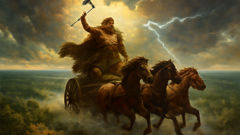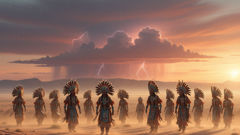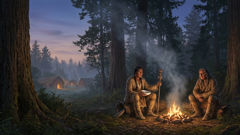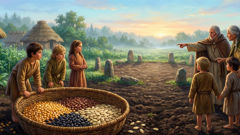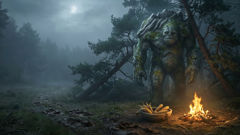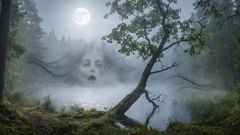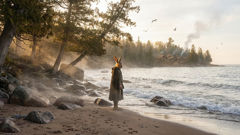Introduction
In the heart of the ancient Baltic lands, long before cities rose and roads cut through wild forests, people looked to the skies and heard the rolling drums of thunder. They believed the world was woven together by unseen forces—spirits who lived in the rivers, trees, and stones. Among these spirits, none was more powerful or revered than Perkunas, the god of thunder. His name rumbled in the mouths of villagers when storms gathered, his presence felt in every lightning flash and every life-giving rainfall. To the Baltic tribes, Perkunas was more than a distant deity—he was a guardian, a judge, and a bringer of both wrath and blessing. He drove a chariot pulled by a team of mighty steeds, their hooves sparking against the sky’s vault. In one hand, he wielded a double-headed axe, its blade forged from the first dawn’s fire. In the other, he carried the weight of justice, ensuring balance between the living world and the mysterious forces beneath it. Each spring, when the earth thawed and the forests burst with green, the people gave thanks to Perkunas for awakening the land. But as summer deepened and storms returned, they watched the horizon anxiously, knowing that every thunderclap might be a sign of his ongoing battle against evil. The myth of Perkunas is not only a story of storms and power; it’s a tapestry of justice, courage, and the eternal dance between darkness and light—a tale as old as the Baltic stones and as alive as the rain that feeds their forests.
The Dawn of Thunder: Perkunas’s Rise Among the Gods
Before the world was divided into fields and forests, before men raised their voices in song or sorrow, the land that would become Lithuania was a tangle of ancient trees and bottomless lakes. In this primeval world, spirits drifted like mist through every glade, and gods shaped reality with their will. Perkunas was born from the union of sky and earth, his first cry echoing as a crack of thunder that split the dawn. From the earliest times, he was marked as a god of power, but not of cruelty—a force that protected as much as he punished.
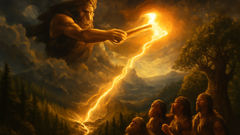
The other gods watched as he grew, his hair wild as storm clouds, his eyes blue as summer lightning. Laima, goddess of fate, saw in him a defender—someone to keep the world from being swallowed by chaos. Žemyna, mother of the earth, felt the rain he summoned soak her soil, turning seeds into lush meadows. Even the silent forests seemed to lean toward his presence, their trunks trembling as his chariot rumbled through the heavens.
Perkunas was not alone in his vigil. The world teemed with spirits—some gentle, some mischievous, some hungry for darkness. Among these was Velnias, lord of the underworld, who crept through shadows and whispered to men’s fears. Velnias envied Perkunas’s strength and the devotion he inspired. Where Perkunas brought rain and renewal, Velnias brought drought and decay, twisting roots and turning hearts against one another. Their rivalry would become the axis on which the world spun, a struggle that mirrored the seasons themselves.
As the first people settled in the clearings, they learned to read Perkunas’s moods. When his voice thundered from the hills, they gathered at sacred oaks, offering honey, mead, and songs. They begged him to spare their harvests, to drive Velnias and his spirits deep underground. Sometimes, on storm-lit nights, villagers claimed they saw Perkunas himself descending—his boots striking sparks on stones, his cloak whipping in the wind, his laughter shaking the sky.
He was not always distant. Stories spread of Perkunas walking among mortals, his form disguised as a humble traveler or wandering bard. He listened to grievances, righted wrongs, and tested the courage of those who claimed to honor him. Children grew up knowing that thunder was both a warning and a promise: evil would not go unpunished, and the just would find protection. The forest, the field, and the furrow all belonged to Perkunas, and he watched over them as a father might watch over restless children.
Perkunas’s earliest battles shaped the very landscape. It was said that when he hurled his axe at Velnias, the weapon carved deep valleys and split mighty rocks. Rivers followed the paths of his lightning, while the highest hills were crowned where his chariot wheels had spun in anger. Each year, as spring thundered in and the land was reborn, the people retold the stories—reminding themselves that their world endured because Perkunas still rode the storm, ever vigilant against the creeping dark.
The Battle with Velnias: Thunder’s Wrath and the Roots of Justice
As years passed and human settlements flourished, Velnias’s jealousy deepened. The underworld lord could not bear the laughter in the fields after a summer rain or the songs rising from harvest feasts. So he sent his minions—shadowy spirits that crept into homes by night, souring milk, blighting crops, and whispering suspicion into sleeping ears. With each calamity, people grew fearful, but they never abandoned their faith in Perkunas.
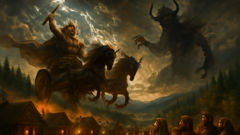
One night, as autumn’s chill stole into the land, Velnias slipped from his cavernous lair. He rose like mist, unseen but felt—a tension in the air, a hush in the woods. He crept into villages, twisting dreams into nightmares, sowing distrust between neighbors. He called forth storms of his own, not of life-giving rain, but of icy wind and relentless hail that battered fields and stripped orchards bare.
The people cried out for help. At the sacred hilltop, they lit fires and sang to Perkunas, their voices trembling yet strong. The thunder god heard. He mounted his chariot and raced across the sky, the wheels roaring like waterfalls, the horses snorting bolts of lightning. His anger shook the heavens. Storm clouds gathered, and from their depths, Perkunas hurled his axe. Each throw blazed with purpose—seeking not merely to punish, but to drive evil back into the shadows.
The battle raged for three days and nights. Lightning clashed with shadow, thunder rolled over the forests, and hailstones as large as fists rained down. In the midst of chaos, villagers gathered together, sharing what food they had, tending the wounded, and praying for dawn. Some claimed to see Perkunas himself striding among them, his cloak trailing sparks, his eyes fierce but kind. He stood guard at village boundaries, daring Velnias to cross the lines of flame.
At last, Velnias was forced to retreat, driven underground by Perkunas’s unyielding strength. In his wake, the land was battered but not broken. The next morning, as the sun rose over waterlogged fields, shoots of green pushed through the mud—evidence that life would return. The people rejoiced, praising Perkunas not only as a warrior, but as a just judge who punished wickedness and rewarded courage. From that time, thunder was seen as both warning and comfort—a sign that justice would always return, no matter how dark the night.
The Fertility of the Land: Rain, Renewal, and the Sacred Cycle
When peace returned after each battle, Perkunas turned his attention to the land itself. He was not merely a god of war or vengeance; he was also the bringer of rain, the father of renewal. Every drop that fell from his storms was a blessing, coaxing seeds from dark earth and filling rivers to nourish all life. The people understood this sacred cycle and honored it with rituals woven into every season.
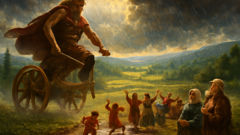
Springtime was Perkunas’s favorite—when icy rivers broke free and sap rose in birch and pine. Villagers gathered at ancient stones or under the spreading arms of oaks to offer him bread, mead, and garlands of wildflowers. They believed that their prayers would call forth gentle rains, that thunder’s voice would wake the sleeping earth. When rain finally came, it was as if the sky itself was singing—a deep, rolling melody that filled every hollow and made fields shimmer with promise.
Perkunas watched over the forests too. He loved the whisper of leaves, the cool shade beneath ancient branches, the flash of deer darting through mossy glades. His storms refreshed the woodland streams and cleansed the air of pestilence. The people followed his example, treating their forests as sacred places—never taking more than needed and always offering thanks. They knew that Perkunas could be wrathful if they disrespected nature; a summer drought or a sudden flood was a reminder to stay humble before the forces that ruled the wild.
Throughout the year, Perkunas’s presence was felt in countless ways. When a farmer heard distant thunder, he paused his plowing and looked to the sky in gratitude. When a mother heard rain tapping against her roof at night, she whispered a prayer for healthy crops and safe children. Young couples danced in fields after a storm, believing that Perkunas’s rain would bless their love and ensure strong offspring.
Yet even in times of plenty, the people remembered that balance was everything. Too much rain could ruin a harvest; too little could bring famine. Perkunas was not a simple god—he held both blessing and burden in his hands. Through him, the Baltic tribes learned respect for cycles, for patience, and for the mysterious ways in which justice, like rain, must sometimes be waited for, but would always return.
Conclusion
So the legend of Perkunas endured—carried in the rumble of distant thunder, whispered in forests where ancient trees still stand. The people of the Baltic lands understood that the world is not simple; good and evil twist together like roots below the soil, and justice is won only through courage and patience. Perkunas’s storms taught them to honor the cycles of nature, to trust in renewal even after hardship, and to believe that every storm would pass. His axe, hurled from the heights, carved not just valleys but the path of their stories—reminding them that strength and compassion can live together in one heart. To this day, when thunder rolls across Lithuanian skies and rain nourishes fields, the spirit of Perkunas rides with it—a protector, a judge, and a giver of life.

